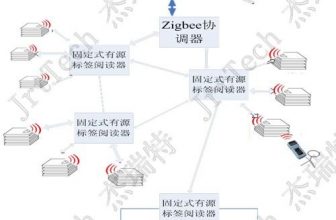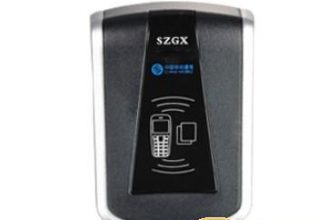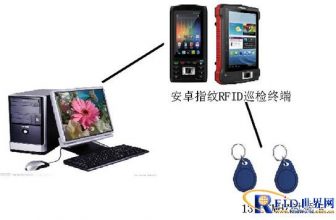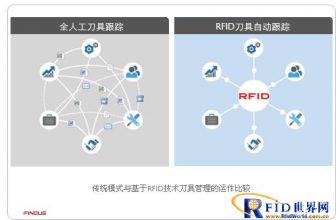
Baseband digital signal processing receiver performance bottleneck solution
[ad_1]
1 Introduction
UHF RFID system air interface standards include ISO/IEC series, F2C series, and national standards under study and development in China. Digital receivers can realize software upgrades and multi-protocol support. Compared with analog receivers, they are easier to debug and have flexible applications. Advantages, so it has been widely used in UHF readers. Improving the reading effect of UHF RFID readers has been the focus of research in recent years. After detailed analysis and experimental verification, this article gives solutions to related problems.
UHF RFID readers use the principle of backscattering to complete communication with the tag. According to the current main UHF frequency band air interface standard ISO/IEC 18000-6C, the tag communicates in the same frequency half-duplex mode under the passive state. . The basic communication process is that the reader adopts amplitude shift keying (ASK) and other methods to modulate the carrier wave, and sends information to one or more tags on a channel of a specific frequency. After that, the reader still needs to transmit the CW carrier wave and wait for the tag’s response within the specified time.
The zero-IF architecture has the advantages of not requiring an intermediate frequency link, reducing power consumption, reducing circuit complexity, and being easy to debug. The block diagram of the zero-IF RFID digital receiver circuit is shown in Figure 1. The RF signal received by the antenna passes through the circulator and directly enters the downconverter. The converted baseband signal is amplified by LNA, low-pass filtered, and two I and Q baseband signals are output to the baseband for digital signal processing.
Figure 1 Block diagram of zero-IF RFID digital receiver circuit
The communication effect of the reader is affected by parameters such as transmitter output power, receiver sensitivity, transceiver antenna gain, transceiver isolation, tag power consumption, tag antenna gain, and environmental conditions. Among them, the maximum effective omnidirectional transmit power (EIRP) of the transmitter is regulated by the national radio transmission equipment, and the transceiver isolation is limited by the isolation of circulators and other devices (generally only up to 25dB), and certain conditions such as tags, antennas and environment Below, the performance of the receiver plays a decisive role in the overall performance of the reader.
2 Analysis of receiver performance influencing factors
When the UHF RFID reader/writer receiver works, the transmitter also needs to send out an unmodulated carrier wave. What the receiver receives includes tag reflection signals, antenna noise, environmental reflections, direct transmitter coupling, and the receiver’s own noise. On the premise that the tag can obtain sufficient working energy, the working distance of the reader mainly depends on whether the demodulation output of the tag backscatter signal at the reader can meet the minimum signal-to-noise ratio requirement.According to the literature [3], The following formula can be used to indicate the maximum working distance determined by the reader:
Among them, C is the propagation speed of electromagnetic waves in free space, ω is the angular frequency of the electromagnetic wave signal, Г is the tag power reflection coefficient, ξ is the transceiver isolation coefficient, GR is the reader antenna gain, Gt is the tag antenna gain, in the denominator Ppn represents the phase noise power in the single sideband passband of the local oscillator, which can be obtained by calculating the known phase noise data of the local oscillator or using a spectrum analyzer (SPA) to directly measure it. The PDATA in the numerator represents the signal power in the single sideband passband of the tag binary data sequence, which can be obtained by numerical calculation. According to the formula, the working distance of the reader depends on the signal-to-noise ratio (SNR) performance of the receiver, especially the phase noise and the effect of noise reduction processing, when the tag parameters, antenna gain, and transceiver isolation are fixed.
Environmental refraction interference and phase noise are mainly near the carrier frequency and appear as low-frequency noise after down-conversion; common high-frequency noise is mixed on the baseband signal. In the dense reader mode, the receiver bandwidth needs to be controlled within a certain range to avoid The readers interfere with each other, so the baseband signal needs to be band-pass filtered to improve its signal-to-noise ratio.
DC offset is a unique interference of the zero-IF structure. It is formed by the coupling of signals such as the local oscillator in the receiver, transmitter leakage, and environmental reflections to the mixer input. The same frequency of the reader’s transceiver causes the DC offset to be much larger than that of the conventional receiver. In addition, the common working distance is only 3-5 meters. The carrier leakage is also affected by the antenna feeder and the environment, and the DC offset is time-varying. The DC offset not only destroys the DC operating point of the subsequent circuit, but also affects the linearity performance of the amplifying and filtering circuit, and makes the signal-to-noise ratio worse. In a single antenna design using a circulator, the limited isolation of the circulator leads to a large transmission leakage to the receiving end, and the DC offset problem will be more serious. DC offset, amplitude and phase interference caused by environmental reflections, local oscillator phase noise, ADC The quantization noise can reduce the signal-to-noise ratio of the receiver, and to improve its performance, in addition to improving the analog radio frequency circuit, corresponding measures must be taken in the baseband signal processing algorithm.
3 Baseband digital signal processing
In order to ensure the correct completion of the decoding, the baseband digital signal processing needs to complete the elimination of noise and interference, and complete the ASK signal decision in an appropriate manner. The key processing measures include: oversampling and filtering, DC offset correction, data decoding, etc.
3.1 Oversampling and filtering
According to the Nyquist sampling theorem, in order to restore the sampled signal to the original continuous signal, the sampling frequency should be at least twice the highest frequency of the signal. Oversampling is to increase the sampling frequency by one on the basis of the Nyquist frequency. The level of sampling multiple law, oversampling can reduce the power of quantization noise in the effective bandwidth and improve the signal-to-noise ratio, which is equivalent to increasing the resolution of the ADC. The data obtained by oversampling can be extracted with a CIC filter to bring the data rate back to Normal level, and then cascade FIR filters for band-pass filtering to further reduce the noise power and improve the signal-to-noise ratio.
Take the common ASK tag return signal with a code rate of 250kbps as an example. In order to match the performance of the ADC chip, the oversampling factor is selected to be 40, and the sampling rate is 20MSI. The code rate after decimation is set to 8 times the code rate of the return data, that is, 2Mbps, and the number of CIC filtering stages is 3.
Most of the signal power of FM0 encoding is within the first zero point. Usually the first zero point bandwidth is 2 times the communication rate. After clock jitter is added, the maximum first zero point bandwidth can reach 2.5 times the communication rate. Therefore, the low-pass cut-off frequency is set to 650kHz; considering the V characteristic point of the sync head, the high-pass cut-off frequency can be set to 160kHz in order to filter out the out-of-band noise as much as possible under limited resource conditions. Figure 2 shows the designed band-pass filter amplitude-frequency characteristic curve.
Figure 2 Amplitude-frequency characteristic curve of band-pass filter
3.2 DC offset correction
The methods to deal with DC offset by circuit hardware include: AC coupling, carrier cancellation, harmonic mixing, self-correction compensation, etc., among which harmonic mixing processing and self-correction compensation methods are more complicated, but the effects achieved are limited .literature[4]A processing method of carrier cancellation is mentioned. This method needs to add a compensation circuit and software to the analog radio frequency and baseband unit at the same time, which increases the complexity and cost, and is difficult to debug.literature[5]It is mentioned that the DC part of the signal can be filtered out to reduce the interference of DC offset by simply using the capacitive AC coupling method. This method has the simplest structure and the lowest cost among all the schemes, so it is the most widely used.
The data frame synchronization header sent back by the label includes several leading zeros plus a preamble. The baseband program can only start information decoding and reception after detecting the synchronization header within a specified time. Although the AC coupling mode can reduce the interference caused by signal overload, because the reader works in burst communication mode, the step response characteristic of the receiving circuit will produce a slope effect at the position of the sync head, which often leads to synchronization judgment errors. , The median value can be corrected before baseband signal processing. This method only requires sliding window tracking and pp value averaging on the collected data. The principle is:
In the above formula, c is the median value of the calibrated ADC data, i is the data serial number, x(i) is the original data value, Y(i) is the correction result data of the point, n is the size of the sliding window, and j is the calculation of the sliding window Serial number.
Except that part of the data header cannot be restored due to distortion, the synchronization header data of the communication frame can be restored with a small computational cost, thereby reducing the influence of the DC offset interference on the decoding synchronization.
3.3 Data decoding
Baseband data decoding methods are divided into two types: zero-crossing detection and coherent detection. The working principle of zero-crossing detection is to set a threshold, and compare each data sample in the data buffer with the median value. The absolute value of the difference value is greater than the threshold and greater than the average value, it is judged as 1, otherwise it is judged as 0. Because this method is simple and easy to implement, and even a comparator can be used to realize the judgment, it is widely used in low-end reader products.
Coherent detection has better decoding capabilities, and can achieve far better performance than zero-crossing detection in a use environment with poor input voice. Because FM0 encoding uses orthogonal encoding, it meets:
Before decoding, data arrays S0 and S1 need to be created in advance as symbol templates representing 0 and 1 of FMO encoding. According to the formula, the input data is correlated with S0 and S1 respectively, and the result of the calculation indicates the degree of correlation between the input signal and symbol 0 and symbol 1. The code element template sets the segment length according to the sampling multiple, and the related operations are also performed segmented in the same way. Since the symbol templates S0 and Sl are also orthogonal, which one of the operation result value is larger, it shows which symbol the input data represents. Since the tag return signal is allowed to have a frequency deviation of ±22%, it is difficult to define the starting position of the segmented coherent calculation.references[6] The design uses a method of dividing into multiple groups of correlators to calculate at the same time for processing, which takes up more FPGA resources. A better way is to comprehensively use zero-crossing detection to correct the starting position of the segment at an interval of 3-4 cycles, thus ensuring that the segment calculation process is always synchronized with the signal cycle, so that the resource consumption is not excessively increased. The same effect can still be achieved by downloading.
4 Verification and analysis
According to the above analysis and design of the prototype verification platform, the digital signal processing of the baseband is completed by Altera CycloneII FPGA, and the realized functions include ADC driving, FIFO buffering, CIC filtering and correlation judgment, etc. The processing of the protocol flow is handed over to the soft core embedded in the FPGA The CPU is completed, and the above-mentioned functional blocks are connected to the internal bus of the soft-core CPU in the manner of peripherals. The design of all functional blocks is based on the standard IP library provided by Altera. During the test, the output power of the transmitter antenna port was 30dBm, the working frequency was 915MHz, the circularly polarized antenna of 7dBi was used, and the label used Alien’s products. Set the tag to be 8m away from the antenna, and control the tag’s return rate to 250kdBs.
The original data curve collected by ADC is shown in Figure 3 below (the horizontal axis is the number of samples, and the vertical axis is the different sampled data values). Since there are many complete communication frame data, only the first half of the data of the I channel including the synchronization header and the synchronization code and the processing result are given here.
Figure 3 The original data curve collected by ADC
It can be seen that in addition to the required tag return data to receive the analog output at the zero intermediate frequency, the data frame synchronization header is also mixed with DC offset interference and high frequency noise. Due to the long distance, the pp value of the useful signal is only 110, the waveform is severely distorted, and the signal-to-noise ratio is poor.
After CIC and band-pass filtering, the curve shown in Figure 4 can be obtained. At this time, the filter removes the mixed noise, the waveform becomes relatively smooth and tidy, and it is easier to distinguish the sync header and data bits of the data frame. The figure also shows the decoding curve of zero-crossing detection (located at the bottom of the graph, the upper side of the square wave is marked with 0 and 1 of the zero-crossing detection and the number of sample points; the decoding result is marked below. 2B4: 0, indicating the second byte The 4th bit is decoded as 0), the algorithm has a decoding decision error on the left of the horizontal axis coordinate 240 (1B5:1, symbol 0 is judged as 1), indicating that the ability to deal with distortion and interference is limited.
Figure 4 The effect of direct zero-crossing detection and decoding
At the same time, DC offset correction and coherent detection methods are used to process the same data, and the curves and effects obtained are shown in Figure 5. The decoding result waveform display algorithm improves the decoding effect of the sync header. At the same time, the left side of the horizontal axis coordinate 240 is correctly decoded (1B5:0), which proves that the algorithm can still obtain the EPC data correctly when the return signal amplitude of the long-distance tag is relatively small or the value of the tag signal fluctuates.
Figure 5 The effect of DC offset correction and coherent detection decoding
5 Conclusion
This paper analyzes the performance bottlenecks in the design of digital receivers for UHF RFID readers with zero-IF architecture, and clarifies the causes and solutions of noise interference, DC offset, and decoding problems that affect receiving performance. From the perspective of baseband digital signal processing, on the basis of oversampling filter processing, solutions such as DC offset correction and related decoding are given. After testing and verification, the reader can stably read tags at a distance of about 10m at the farthest, and can adapt to changes in antenna and environment. The reading effect is more stable and reliable than common products on the market. It is proved that the design requirements for increasing the working distance of the reader are met.
[ad_2]






